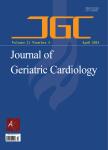Atrial fibrillation in the elderly: the potential contribution of reactive oxygen species
Atrial fibrillation in the elderly: the potential contribution of reactive oxygen species作者机构:Penn Cardiovascular Institute and Section of Cardiac Electrophysiology University of Pennsylvania Philadelphia PA 19104 USA
出 版 物:《Journal of Geriatric Cardiology》 (老年心脏病学杂志(英文版))
年 卷 期:2012年第9卷第4期
页 面:379-388页
核心收录:
基 金:National Institutes of Health, NIH: 01 CA70833 Winship Cancer Institute
主 题:Aging Arrhythmia Atrial fibrillation Cardiac Free radicals Oxidative stress Redox
摘 要:Atrial fibrillation (AF) is the most commonly encountered cardiac arrhythmia, and is a significant source of healthcare expenditures throughout the world. It is an arrhythmia with a very clearly defined predisposition for individuals of advanced age, and this fact has led to intense study of the mechanistic links between aging and AF. By promoting oxidative damage tomultiple subcellular and cellular structures, reactive oxygen species (ROS) have been shown to induce the intra- and extra-cellular changes necessary to promote the pathogenesis of *** addition, the generation and accumulation of ROS have been intimately linked to the cellular processeswhich underlie aging. This review begins with an overview of AF pathophysiology, and introduces the critical structures which, when damaged, predispose an otherwise healthy atrium toAF. The available evidence thatROS can lead to damage of these critical structures is then reviewed. Finally, the evidence linking the process of aging to the pathogenesis of AF is discussed.



